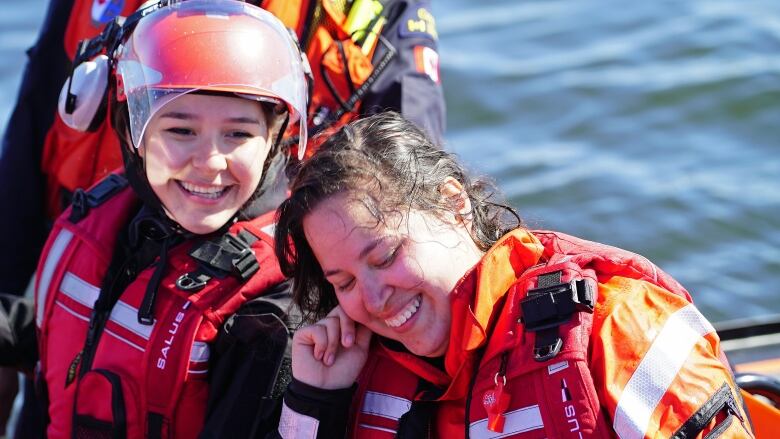Canada's coolest summer job mixes adrenaline with reconciliation
Northern Coast Guard rescue station to be crewed almost entirely by Inuit post-secondary students

Canada's Coast Guard is about to open something it's never had before — an inshore rescue boat station in Canada's North.
The high-speed vessel will be based in Rankin Inlet, Nunavut, on the northwestern shores of Hudson's Bay, able to respond to boaters in distress, missing hunters, potentially even plane crashes and major ship emergencies.
The new station augments the current patchwork system of community volunteers and professional resources, which are deployed from as far away as Winnipeg when someone needs to be rescued.
And the new rescue boat will be crewed almost entirely by post-secondary students from Inuit backgrounds, something the young Inuit say will help as Canada attempts to reconcile its past with Indigenous people, including those across the vast Arctic region.
New northern crew

Ciera Lee-Kooneeliusie (left), of Pangnirtung, Nunavut, and Allison Baetz, of Inuvik, N.W.T., are two of the Inuit students hired to crew the Inshore Rescue Boat Station.
Before the ice breaks up in Hudson Bay, they face 16 days of intensive initial training in Southern Ontario, followed by several more weeks of on-water specialist training in high-speed manoeuvring, first aid, firefighting and maritime search and rescue.
Joint Rescue Coordination Centre

The Joint Rescue Coordination Centre (JRCC) at CFB Trenton serves as Canada's national 911. Maritime, aviation and remote land emergencies are relayed to the centre, which can then rapidly deploy rescue planes, helicopters and ships — including resources from Canada's newest rescue station in Rankin Inlet, the first-ever in the North.
Airborne response will still be required for emergencies in much of the North, but the several communities and huge land expanse around Rankin Inlet will be served by the new rescue boat crew.
Watching for trouble

Screens at the JRCC indicate the precise geographic location of any emergency beacons activated across North America.
Building trust

The Rankin Inlet station will operate from June to September, before ice covers the waters.
Each crew includes a coxswain (an experienced supervisor) and four Inuit recruits.
Allison Baetz, left, and Ciera Lee-Kooneeliusie will be on call at all times, working two-week rotations. And though neither comes from Rankin Inlet, they expect their own heritage will make it easier for the community to trust them.
"I think it's going to be a lot easier for Inuit to come up and talk to other Indigenous people," says Lee-Kooneeliusie.
Jacob's Ladder

This Coast Guard exercise on the Bay of Quinte requires the trainees to locate one of their own in the waters of the large bay.
Then the team must quickly perform a rescue using a Jacob's Ladder, a net which spins a person into the emergency boat.
Cold-water immersion

Cold-water immersion is a key part of the rescue boat crew training. It helps recruits understand why, even when a person is wearing a life-jacket, rescue is time-sensitive.
After 10 minutes immersed in nine-degree water, people begin to lose mobility as their muscles and brain start to succumb to the effects of the cold.
After 30 minutes, their arms and legs will be mostly useless, unable to even kick back into a boat.
After a hour in cold water, the risk of a hypothermic death increases substantially.
Fire drill

The new Rankin Inlet team is trained in firefighting techniques by the Quinte Fire Department in Trenton, Ont.
Though other Indigenous people staff the Coast Guard's summer inshore rescue boat stations in southern regions of Canada, there have only rarely been Inuit crew members running the department's search and rescue operations in the North.
Reflecting the community

"Indigenous people coast to coast to coast know their waters, they know their risks," says Coast Guard Commissioner Jeffery Hutchinson.
"We're after a Coast Guard that reflects the Canada we serve. We're proud to serve coast to coast to coast — we want our own ranks to reflect that."
He says other rescue boat stations in the North will be opened, and he hopes they too will be staffed largely by Inuit people from the North.
Reconciliation

"I know that the governments have been working very hard on reconciliation," says Allison Baetz.
"So having this first station in the North … shows that they are working toward what they had promised us. It is taking some time, but this is another little step in the process of getting to good grounds."
Helicopter rescues

"Not a lot of summer students have jobs where they get to say they had a helicopter right above them, where you could almost touch it," says Baetz, seen here at the wheel of the rescue boat during a training exercise.
The team is trained not only to carry out rescues on the water, but to also transfer casualties to Canadian Armed Forces helicopters.
Hands-on training
A Canadian Armed Forces Griffon helicopter circles a Coast Guard rescue boat during training for the boat's new crew on the Bay of Quinte near Trenton, Ont.
Straight to work

The Inuit trainees will begin work immediately when their training is complete — assisting with maritime operations around the G7 meeting in June, before heading north at the end of the month.
They'll work two weeks on and two weeks off at the Rankin Inlet station this summer.
High hopes

The federal agency has high hopes for the new team, says Coast Guard Commissioner Hutchinson.
"We want to work together with people in the North to deliver search and rescue. We want to be connected to the community."
Watch how Inuit summer students are being trained to staff the Canadian Coast Guard rescue boat station in Rankin Inlet:
Photos by David Common
